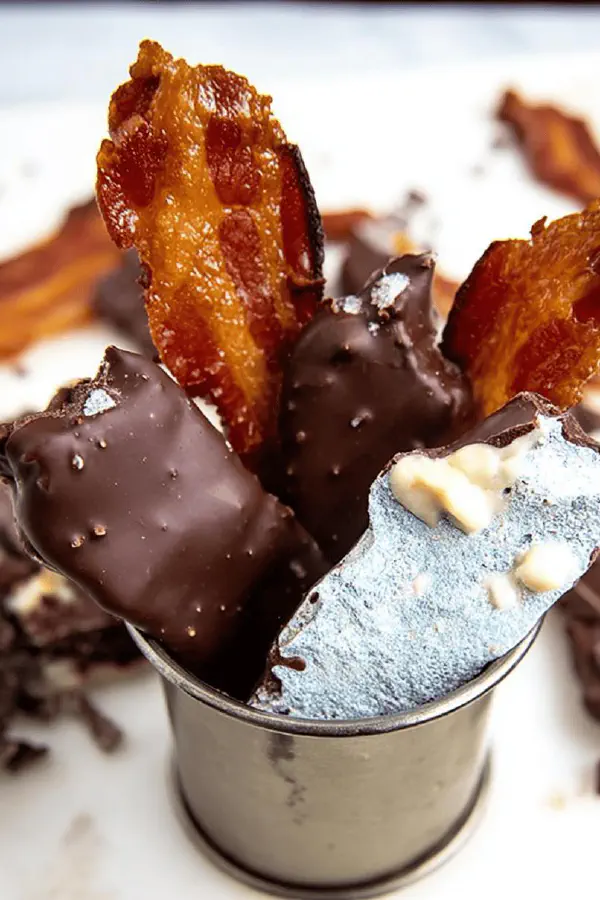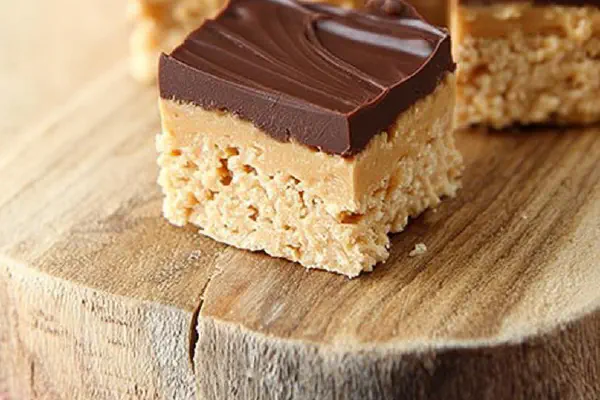Featured Recipe
Chocolate Bacon Bites

By Kate
"
Crispy bacon strips coated halfway in gently melted dark chocolate, sprinkled with crushed pecans and sea salt flakes. Oven baking renders fat slowly, avoiding sogginess. Chocolate tempered carefully in short bursts, preventing burnt or grainy texture. Sweet and salty meets smoky crispness. Chill for firm coating. Store airtight, fridge only. Variations with smoked paprika or chili powder offer savory heat contrast. Beware overcooked bacon: dry and brittle. Chocolate brand matters: pick quality for melt and snap. Efficient setup uses wire rack for even cooking and fat drip-off. Ideal snack or cocktail nibble. Visual cues prioritize color changes and texture feel over strict timing. Real kitchen tested tweaks included.
"
Prep:
20 min
Cook:
20 min
Total:
40 min
Serves:
6 servings
bacon
chocolate
appetizers
desserts
Introduction
Crisp, smoky bacon meets smooth bittersweet chocolate in a combo that takes some finesse to nail properly. Thick slices avoid turning to brittle shards and hold up well to chocolate coating. Watch the bacon closely as it cooks — visual cues like deep amber edges curling up signal readiness better than any timer. Melting chocolate involves short bursts of power, stirring helps keep texture right without burning or graininess. Once coated, sprinkle flaky salt and chopped nuts for contrast and crunch. Patience in chilling yields the satisfying snap you want, not a floppy mess. A dash of smoked paprika or chili adds an unexpected flare. This isn’t simple candy making. It’s the kitchen effort where timing and temperature matter at every stage to avoid greasy, mushy failures and instead get that addictive savory-sweet crispy bite. Storage tips keep your work intact longer. The experience sharpens your senses in heat and chill management—skills every cook fights to master.
Ingredients
About the ingredients
Bacon thickness is key; too thin, and it crisps into fragile pieces that don’t hold chocolate well. Thick-cut slices stay sturdy. If unavailable, guanciale or slab bacon trimmed to similar thickness can substitute for stronger pork flavor. Quality chocolate matters: 60-70% cacao bittersweet bars provide balanced bitter-sweet notes and melt cleanly. Milk chocolate works for milder sweetness but sets softer and may run. Add chopped pecans for crunch and a nutty edge; walnuts or hazelnuts substitute easily. Flaky sea salt provides splash of bright saltiness that coarse table salt cannot replicate—use sparingly. Spice twist of smoked paprika or chili powder cuts richness and adds complexity. If you lack microwave, gently melt chocolate over double boiler with constant stirring. Avoid overheating or moisture contamination—both cause chocolate to seize and grain.
Method
Bake bacon
- Set oven to 395F. Line rimmed tray with parchment paper; place a sturdy oven-safe wire rack on top. Arrange bacon in single layer, not touching. Bacon thickness dictates cooking; expect 15 to 22 minutes crisp. Flip once around halfway through — listen for sizzle subsiding, edges curling uniformly, deep golden brown color, firm but not shattered texture indicates doneness. Avoid overbaking; brittle bacon loses chew and absorbs less chocolate.
- Remove bacon. Dab off excess grease with unbleached paper towel, gently press to avoid breaking strips. Cool on rack for 10 minutes until warm, not hot. Meanwhile, chop chocolate into a heatproof bowl. Microwave in 12-second bursts at medium power. Stir between intervals using rubber spatula to encourage even melting. Watch for glossy sheen just before fully liquefied but unmelted solids remain to avoid graininess. Refine melt on residual warmth. No direct heat to prevent seizing.
- One strip at a time, dip bacon end halfway into melted chocolate. Use spoon to spread and push chocolate on both sides for consistent coverage. Tap wrist lightly to let excess drip off; prevents gloopy clumps. Lay coated bacon on fresh parchment or wax paper in single layer. Immediately sprinkle each piece evenly with chopped pecans and sea salt. Optional: add smoked paprika or chili powder on top before chocolate sets for smoky heat depth.
- Refrigerate bacon flat for at least 50 minutes. Firm surface to simple snap and slight sheen means done. Avoid keeping extended: moisture from bacon softens chocolate coating and reduces crunch retention.
- Serve cold or just off the fridge for contrast of fat richness and crisp chocolate snap. Store in airtight container lined with parchment, refrigerated up to 4 days. Warm bacon loses snap; re-chill before serving. No freezer—chocolate texture may worsen. For softer bite, dip in milk chocolate or white chocolate instead, accounting for shorter fridge set time.
- If bacon greasy after cooling, blot more thoroughly or pat gently but firmly to keep chocolate adherence strong. Overheated chocolate curdles — cool bowl added or fresh batch recommended. Oven rack lets fat drain, preventing bacon sogginess under chocolate. Use thick-cut bacon; thin strips become brittle and hard to handle dipped. For uneven chocolate coating, spoon coating method better than full dip — more control, less mess.
Chill bacon, prep chocolate
Coat bacon and garnish
Set chocolate
To serve & store
Common issues & fixes
Technique Tips
Setup matters — wire rack elevates bacon allowing fat drip without stewing strips, producing dry crisp edges and uniform color. Flip once midway to encourage even cooking and prevent curling too much on one side. Watch sound and sight cues—diminishing sizzle and deep golden edges show doneness better than clock. Remove bacon and blot grease thoroughly to encourage chocolate sticking—too much residual fat leads to slipping, clumping chocolate. Melt chocolate incrementally in low bursts, stirring between intervals helps spread heat evenly. Avoid microwave ovens running full power; rapid overheating leads to burnt or curdled chocolate texture. Dipping bacon one by one with a spoon controlling chocolate layer avoids drowning strips in too much coating. Chocolate thickness here impacts final snap and bitterness. Refrigerate coated strips on flat parchment to prevent sticking and uneven solidification. Chill at least 50 minutes or until chocolate hardens but bacon remains slightly tender. Hold finished product refrigerated; prolonged room temp softens chocolate and bacon fat can go rancid. Store in airtight container, lined with parchment to keep textures fresh without sticking. Re-chill before serving if chocolate softens.
Chef's Notes
- 💡 For crisp bacon, use thick-cut. Thin bacon too brittle. Cooking time: watch for deep amber, curling edges. Flip once. Drain fat well for good chocolate adherence. Sizzle sound fading means done.
- 💡 Chocolate melting: use 12-second bursts. Stir in between. Avoid overheating. Look for glossy sheen, some solids left. That ensures even texture. Always use quality chocolate for better melt and snap.
- 💡 Coat bacon one by one. Dip ends halfway, use spoon for even spread. Excess chocolate can be fixed with light wrist tap for drip-off. Quick work prevents clumps before hardening.
- 💡 Refrigerate coated bacon for firm chocolate coat. Chill flat on parchment. Set for at least 50 mins. Avoid softening. If too warm, refrigerate again. Makes for a better crunch when serving.
- 💡 Bacon greasy after cooling? Blot with paper towel, pressing gently. Overheated chocolate? Consider cooling bowl or start fresh batch. Use a wire rack for even cooking—fat drip-off is key.
Kitchen Wisdom
Why is my bacon soggy?
Check if not drained properly. Use wire rack; keep strips lifted. Not blotting enough grease leads to floppy texture. Texture loudly changes.
Can I use different chocolate?
Yes, milk chocolate works. But softness decreases firmness. Experiment with flavors, but quality always. Try bittersweet for balanced notes.
How to store leftovers?
Use airtight container. Line with parchment. Keeps for up to four days refrigerated. Don't freeze—texture worsens. Re-chill before serving for best crunch.
What if chocolate seized?
Overwhelming heat causes it. Cooling bowl can help. Alternatively, start with new chocolate. Controlled heat protects from graininess.



